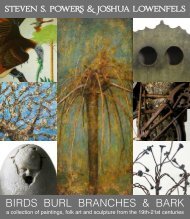WINNOWED
It is not easy coming up with compelling and complex material show after show. This catalog is thinner than usual, but phat as ever—quality over quantity with no filler! Of course, we will be bringing more than these works of art to the fair, but herein are a group of well-winnowed works that deserve special attention. Enjoy! Come see this collection and more at The Philadelphia Antiques & Art Show, April 20-22 (*preview party April 19, 2018). Location: The Navy Yard, 4747 South Broad Street, Philadelphia, PA 19112.
It is not easy coming up with compelling and complex material show after show. This catalog is thinner than usual, but phat as ever—quality over quantity with no filler! Of course, we will be bringing more than these works of art to the fair, but herein are a group of well-winnowed works that deserve special attention. Enjoy!
Come see this collection and more at The Philadelphia Antiques & Art Show, April 20-22 (*preview party April 19, 2018).
Location: The Navy Yard, 4747 South Broad Street, Philadelphia, PA 19112.
You also want an ePaper? Increase the reach of your titles
YUMPU automatically turns print PDFs into web optimized ePapers that Google loves.
W I N N O W E D<br />
PHILADELPHIA ANTIQUES & ART SHOW • A P R I L 2 0 - 2 2
W I N N O W E D<br />
It is not easy coming up with compelling and complex<br />
material show after show. This catalog is thinner than<br />
usual, but phat as ever—quality over quantity with no<br />
filler! Of course, we will be bringing more than these<br />
works of art to the fair, but herein are a group of wellwinnowed<br />
works that deserve special attention. Enjoy!<br />
Come see this collection and more at The Philadelphia Antiques<br />
& Art Show, April 20-22, 2018 (*preview party April 19).<br />
Location: The Navy Yard, 4747 South Broad Street,<br />
Philadelphia, PA 19112.<br />
additional show information: philadelphiaantiquesandartshow.com<br />
W O R K S O F<br />
A R T<br />
& a m e r i c a n a<br />
109 3rd Place #2, Brooklyn, NY 11231 | 718.625.1715 or 917.518.0809 | stevenspowers.com | member: ADA
Folk Art Acrobat Whirligig (detail)<br />
New England<br />
Wood and polychrome<br />
Circa: 1880<br />
*full details pages 8-9.
An Important Pair of African-American (Slave) Made Andirons<br />
Madison County, Tennessee (found)<br />
Circa: 1820 (or earlier)<br />
Size: 14 3/8" (h) x 10 1/2" (deep)<br />
Provenance: Robert Reeves, Private Southern collection, Peter Brams.<br />
Exceedingly rare wrought iron, diminutive African-American (slave) made<br />
andirons in the form of male and female figures. The figures stand in a coded<br />
stance communicating power. The female figure is slightly smaller and has a<br />
triangular notch clipped between her legs designating her gender.<br />
A number of African men who were forcibly brought to America came with<br />
generational expertise in blacksmithing, as iron working was a centuries-old<br />
and honorable tradition in Africa.<br />
The anthropologist, John Michael Vlach writes in, By The Work of Their<br />
Hands; Studies in Afro-American Folklife, “The [slave] blacksmith was the<br />
pivotal craftsman of his community; all other skills in some manner<br />
depended on his efforts.” To this end, the slave blacksmith had a greater<br />
privilege and standing among other slaves. Slave quarters were barren but<br />
had basic necessities like a small hearth, iron kettles, and simple furniture<br />
(which they often made themselves). Vlach further writes, “slaves<br />
surreptitiously took partial control of their own lives by establishing a sense<br />
of place...for those slaves with either a personal experience of Africa or the<br />
memory of strong ancestral direction, the slave-made landscape provided the<br />
means to recapture a measure of freedom symbolized by the mother<br />
continent.” It was the small things in their living quarters that they could<br />
make personal, like clothing, tools or music that provided a sense of life in<br />
otherwise dark circumstances.
Early African-American, slave-made ironworks are remarkably scarce. A<br />
documented wrought iron figure, formerly in the Adele Earnest collection,<br />
was excavated in slave quarters in Alexandria, Virginia and is “one of the<br />
rare objects which link American Negro Art to Africa” (Made of Iron, 1966,<br />
p. 107). It has been put forth that the Earnest figure relates to Mande,<br />
Bamana made figures. Mande made iron figures feature small heads and thin<br />
wrought bodies, similar to those seen on these andiron figures. And a wood<br />
figure, from the Lega culture and in the Brooklyn Museum displays the same<br />
posture as these figures and has an incised notch between the legs.<br />
These small andirons, placed within a modest hearth provided a platform for<br />
warmth and cooking and in a subtle, but meaningful way served as proud<br />
and poignant reminders of personal identity and cultural heritage.<br />
Female Iginga, Lega culture, 19th–20thC,<br />
Brooklyn Museum (74.66.1). Note posture<br />
of arms and legs and notch in pelvis.<br />
Photo of a slave cabin’s hearth.<br />
Thornhill Plantation, Forkland, Greene County,<br />
AL. Photo by Alex Bush, 1934.
Folk Art Acrobat Whirligig<br />
New England (Massachusetts)<br />
Circa: 1880<br />
Size: 14" (oah) x 4 1/2" (w)<br />
Provenance: Stephen Score; Olde<br />
Hope Antiques; Private Southern<br />
collection<br />
First rate folk art whirligig in the<br />
form of an acrobat with red face<br />
paint, a red and white uniform and<br />
blue paddles. The original paint<br />
surface is in a remarkable state of<br />
preservation and maintains a<br />
complex craquelure and<br />
patination—one of the very best I<br />
have seen.
The Venus of Baltimore<br />
Carved walnut by A. Leibniz<br />
Baltimore, Maryland<br />
Dated: 1909<br />
Size: 15 3/4" (h) x 10" (w) x 10" (l)<br />
Provenance: Harris Diamant; Hill Gallery;<br />
Private Southern collection<br />
Related: see American Vernacular, p. 164<br />
for a walnut carved female figure found in<br />
Baltimore.<br />
A striking, bold and sensual folk art<br />
carving by a very skilled artisan. A young<br />
nude woman stands with her arms above<br />
her head, leaning contrapposto against a<br />
tree stump above an elaborate carved<br />
floral base, which is cornered by dogs and<br />
elephants(?). The animals have black glass<br />
beads and rhinestone inset eyes. It should<br />
be noted that each side of the base is<br />
carved slightly different than the<br />
other—each with a different floral<br />
and base molding motif.
Ojibwa Mide'wiwin Figures<br />
Cottonwood, pigment<br />
Circa: 1840<br />
Size: 6" (oah)<br />
Provenance: W. E. Channing; Marvill Collection; Private<br />
Related examples: Denver Art Museum, 1946.265, 1946.266 for a near<br />
identical pair; Logan Museum of Anthropology, Albert Green Heath<br />
Collection, Beloit, WI, pair of like figures; The American Museum of<br />
Natural History, 50 / 5695 N, small female form medicine figure.<br />
These rare Woodlands figures were used by the Mide'wiwin or "Grand<br />
Medicine Society" of the Ojibwa Indians. As part of a<br />
ceremony for attracting a marriage<br />
partner, the figures would be tied face to<br />
face and mixed with “love powder” in a<br />
bag.<br />
Excerpted from: THE MIDĒ´WIWIN OR<br />
“GRAND MEDICINE SOCIETY” OF THE<br />
OJIBWA, by W. J. Hoffman.<br />
“This love powder is held in high esteem,<br />
and its composition is held a profound<br />
secret, to be transmitted only when a great<br />
fee is paid. It consists of the following<br />
ingredients: Vermilion; powdered<br />
snakeroot and a piece of ginseng cut from<br />
the bifurcation of the root, and<br />
powdered.”<br />
A Pair of near identical figures from the<br />
collection at the Denver Art Museum,<br />
1946.265
Ojibwa Pictographic Textile<br />
Yarn on linen<br />
Circa: 1900-1920<br />
Size: 28" (w) x 28" (h)<br />
Provenance: Rev. Ellen Grant Gustin (1836-1924) of Attleboro, MA<br />
The Ojibwa and other Native tribes have a long history of using pictographic<br />
imagery for storytelling—from medicine scrolls, spirit sticks and in many<br />
instances ledger drawings of the Plains Indian tribes.<br />
An old label, attached to the textile, reads, “This is an Indian prayer rug used<br />
by the Ojibway and presented by one of the Indians as a friendly and<br />
protective offering for kindness received. — E. G. G.”<br />
Though this rare textile is misidentified as a prayer rug (the Ojibway were not<br />
weavers) and it is not known if the full textile has any narrative, we may infer<br />
that the figures on the upper left may represent Ms. Gustin and the father of<br />
the Ojibwa child who may have created the textile for Guston (possibly for<br />
religious instruction). The stylized headdresses are quite remarkable and I<br />
love the image of the Indian child standing atop the horse.<br />
The Rev. Ellen G. Guston was a<br />
strongly spoken preacher, a<br />
pioneer woman suffragists and<br />
President of the Women’s Board<br />
of Foreign Missions. In 1877,<br />
Gustin was part of a “small but<br />
radical Christian denomination,<br />
[and] preached a series of revivals<br />
in Westerly, Rhode Island [and]<br />
caused such a commotion that her<br />
preaching got national attention.”
Adolph Kronengold (1900-1986)<br />
(ul) Hudson River Brick Factories;<br />
(ur) Meatpacking District;<br />
(ll) Brooklyn Bridge; (lr) Westside Passenger Piers<br />
Oil on canvas board<br />
Circa: early-mid 1920’s<br />
Size: each 6" x 8" (sight)<br />
11 1/2" x 13 1/2" (framed)<br />
Kronengold was born in New Orleans and<br />
studied at New York’s Art Student League and<br />
the Pennsylvania Academy of Fine Arts. In the<br />
late 20’s and 30’s he was a leading cover<br />
illustrator for the New Yorker.<br />
These four small, en plein air, paintings exhibit<br />
an assured handling of paint with broad strokes<br />
and blocks of color that readily define the space<br />
and light of scenes in and around New York City.
Ida Jones (1874-1959)<br />
Mock Orange [Philadelphus]<br />
Oil on canvas board<br />
Circa: July, 1952<br />
Size: 20" (w) x 16" (h)<br />
Mockorange, (Philadelphus), is a shrub with a citrus scent and has white<br />
blossoms that bloom in the late spring to early summer. A portion of<br />
this painting can be seen in the upper left corner of the photo herein—<br />
Jones in her living room/studio.<br />
Ida Jones, the daughter of a former slave, had ten children and at the age<br />
of seventy-two began painting. Self-taught, her work focuses on local<br />
(Chester County, PA) landscapes, still-lifes and Biblical stories<br />
The Chester County Historical Society held a retrospective exhibit in<br />
1995 and Jones was recently included<br />
in “We Speak: Black Artists<br />
in Philadelphia, 1920s-1970s, ”<br />
2015.<br />
Literature: Starting Anew After<br />
Seventy: The Story of Ida Ella<br />
Jones, Primitive Artist, by Ida J.<br />
Williams, 1980.<br />
To Everything a Season: The Art<br />
and Life of Ida Jones, by Beverly<br />
Sheppard and Roberta Townsend,<br />
1995.<br />
Photo of Jones at the easel in her living room. A<br />
portion of this painting is shown in the upper left<br />
corner. Photo circa 1955.
M.L. Snyder<br />
held their own on the galle<br />
A Set of Three Folk Art Bakery Signs<br />
De Kooning, Kline and othe<br />
Maytown, Pennsylvania<br />
the map and Thiebaud’s ear<br />
Painted wood<br />
widely held as seminal wor<br />
Circa 1901<br />
Sizes: (l) 15" x 15 1/4"; (c) 13 3/8" x 17 1/4"; Though we are not sure wh<br />
(r) 19" x 15"<br />
paintings came into Stone’s<br />
The Newport Zoo had his name all over them<br />
Provenance: Allan Stone Collection Newport, KY<br />
Dated: April 6, 1925 Each is signed “M. L. Synde<br />
In 1962, a then-unknown Wayne Size: Thiebaud 11 1/2" (w) x 5 1/4" further (d) x signed 3 1/2" and (h) dated on<br />
walked into the Allan Stone Gallery and<br />
May 6, 1901”<br />
showed him his paintings of cakes A large and and unusual piece of Southern<br />
pastries. At first, the paintings perplexed ceramics featuring a menagerie of<br />
Stone and he thought they just might animals—an be the alligator, birds, a fish, and a<br />
craziest things of earnest he had turtle. ever seen.<br />
But to his amazement, he noticed that they
y walls—mixed amoung<br />
rs. Stone put Thiebaud on<br />
ly cake paintings are now<br />
ks of early Pop Art.<br />
en this set of cake<br />
collection—they certainly<br />
!<br />
r” and the center one is<br />
the back, “Maytown, PA /
Pebble People<br />
Arizona<br />
Circa: 1899-1900<br />
Sizes range from: 3/4" - 2 1/4" (oah)<br />
A fascinating group of seven carved<br />
stones, each in the form of a man’s face<br />
with a pronounced, well-groomed<br />
mustache.<br />
Though the carver’s identity is unknown,<br />
three of the stones are dated; 1) July 15,<br />
1899; 2) Oct. 1899; 3) July 15, 1900
Frederick Hastings (1919-2013)<br />
A Group of Five Figures<br />
Steel, air-dried clay, paint, cardboard, cotton, lead and masking tape<br />
Circa: 1960-80<br />
Size: range from 2 1/2" - 7 1/4" (oah)<br />
The work of Frederick Hastings was discovered a few years ago and<br />
much of the details of his life and work remains a mystery. The two<br />
larger are made from steel armatures under air dried clay and the<br />
smaller three are steel armatures under painted lead.<br />
What is known is that he lived outside of Philadelphia, was an architect<br />
and may have had family money. It is also known that he was into<br />
trains and built elaborate sets.<br />
The figures are very well made, with steel armatures or skeletons and<br />
then carefully modeled with some sort of air-dried clay or modeling<br />
putty. Most have applied paper bikinis and several have wigs of cotton<br />
or wool. Most of the figures come with hand-made boxes, custom fit to<br />
accommodate the size and posture of each.<br />
At first glance the figures appear hermaphroditic or trans-gendered,<br />
however, none have genitals—just muscular bodies with breasts. And<br />
though great effort is put into modeling and composing the figures,<br />
there appears to be no attempt to idealize or beautify the faces—which<br />
are often quite severe and grotesque.<br />
During the same period in which Forrest Bess was exploring sexuality<br />
through hermaphroditism, Hastings was engaged in exploring the<br />
boundaries of masculinity and femininity.
American Folk Art Ventriloquist’s Head<br />
Wood, polychrome and wool hair<br />
Circa: 1900<br />
Size: 20 1/2" (oah)<br />
Pictured and discussed in American<br />
Vernacular, page 84.<br />
A striking example with first rate paint<br />
and features—look at those eyelashes!
(l) A Folk Art Cane for Elias H. Gilbert<br />
Pottstown, Pennsylvania<br />
Circa: 1890<br />
Size: 37" (oah)<br />
Gilbert was the owner of the Merchants’<br />
Hotel in Pottstown, PA and was one of<br />
the town’s most popular citizens. In 1904<br />
a newspaper wrote about Gilbert’s trained<br />
pig and noted that it could “count, walk<br />
on two feet and do some clever stunts.”<br />
Gilbert went on to become a PA State<br />
Representative from 1907-1910.<br />
The cane features Gambrinus atop a beer<br />
keg with his right arm making a toast<br />
with a stein. Behind him, a goat and a<br />
dog appear at opposite ends of a barrel.
(c) Folk Art Cane of a Black Man<br />
Circa: 1880<br />
Size: 37 1/2" (oah)<br />
Likely Southern and African American carved.<br />
Very powerful piece.<br />
(r) Folk Art Cane of a Monkey, Snake and Lizard<br />
Circa: 1880-1900<br />
Size: 36" (oah)<br />
Very fine and skillfully carved with a monkey<br />
atop a pole with inset mother-of-pearl eyes—<br />
the snake with hundreds of individually carved<br />
scales and inset blue glass eyes.
To Have and To Hold<br />
Folk Art Painted Tintypes<br />
Circa: 1860-1880<br />
Size: +/- 7" x 10"<br />
(slightly larger than<br />
typical full plate)<br />
A rare pair of African<br />
American tintypes of a<br />
husband and wife.<br />
Both figures are quite<br />
striking—sophisticated,<br />
strong—and look at that<br />
dress!
An Arranged Marriage<br />
Folk Art Painted Tintypes<br />
Circa: 1860-1880<br />
Size: +/- 7 1/8" x 10 1/8"<br />
(slightly larger than<br />
typical full plate)<br />
Though these were found<br />
separately, the plate size<br />
and unusual mountainous<br />
lake backgrounds are<br />
more/less the same and<br />
the sitters make a nice<br />
“marriage.”
Folk Art Painted Tintype<br />
Circa: 1860-1880<br />
Size: +/- 6 1/2" x 8 1/2" (full plate)<br />
Charming portrait of a young<br />
red-headed boy in a dress atop a<br />
wonderful green floorcloth.
Folk Art Painted Snuff Box of a Black Man<br />
Circa: 1820-1840<br />
Size: 3 5/8" (d)<br />
I have handled a good number of<br />
lacquered papier-mache snuffboxes and<br />
have seen thousands more—this is the<br />
first example that I have had of a fully<br />
painted miniature of a black man's face.<br />
The face occupies the full round—it is<br />
quite effective. The lacquer is of very good<br />
quality and it probably English or<br />
Continental of the Saundauer type.
S T E V E N S . P O W E R S<br />
W O R K S O F<br />
A R T<br />
& a m e r i c a n a<br />
109 3rd Place #2, Brooklyn, NY 11231 | 718.625.1715 or 917.518.0809 | stevenspowers.com | member: ADA


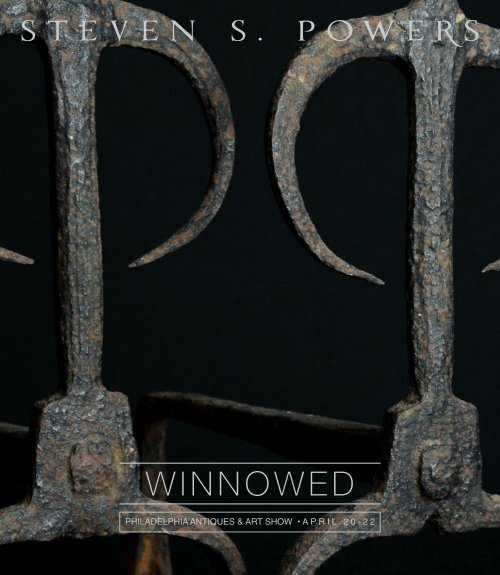

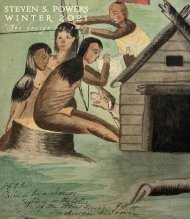
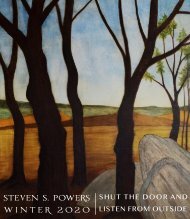
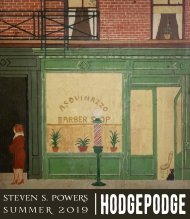
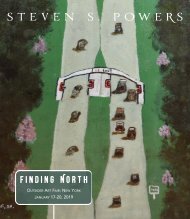
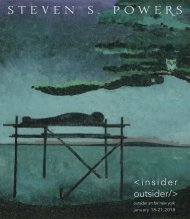
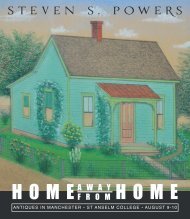
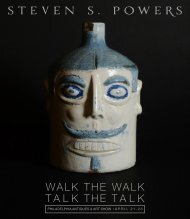
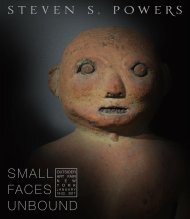
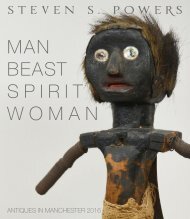
![NEEDLE • KNIFE • TORCH [&] BRUSH](https://img.yumpu.com/55309753/1/190x219/needle-o-knife-o-torch-brush.jpg?quality=85)
